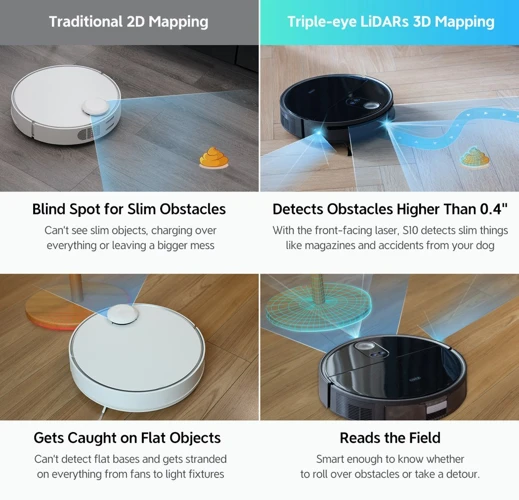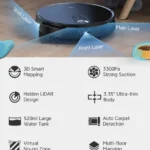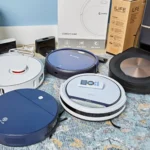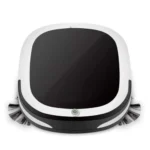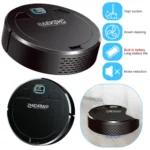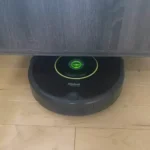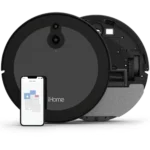Imagine having a sparkling clean house without lifting a finger! Sounds like a dream come true, right? Well, with smart vacuum cleaners, that dream is now a reality. However, as with any advanced technology, there are challenges that need to be addressed to make the experience seamless. One such challenge is obstacle detection and avoidance. How do these smart machines navigate around your furniture and other obstacles without getting stuck or causing damage? In this article, we’ll explore the inner workings of obstacle detection and avoidance in smart vacuum cleaners, and the future advancements that will make them even more efficient in cleaning our homes.
What is Obstacle Detection?
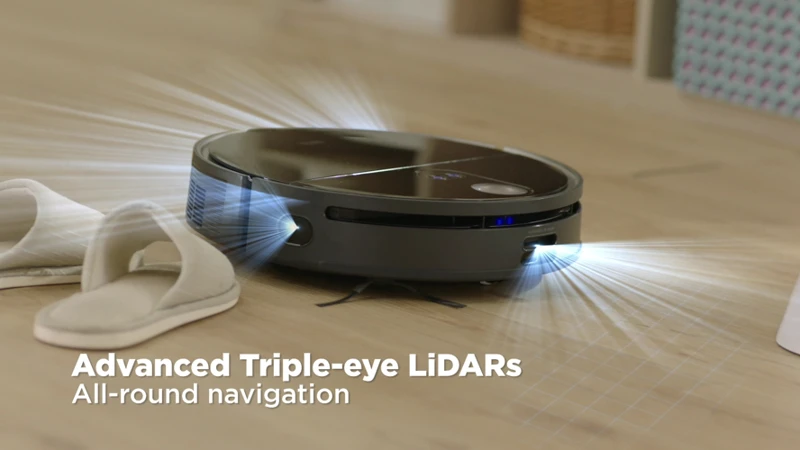
As smart vacuum cleaners are becoming increasingly popular, obstacle detection technology has become a vital feature in these smart appliances. Obstacle detection enables the vacuum cleaner to navigate around the room without bumping into walls, furniture, or other items. This feature allows the vacuum cleaner to clean a room thoroughly without requiring any human guidance. In this section, we will discuss what obstacle detection technology entails, how it works, and the different types of sensors used in smart vacuum cleaners to enable obstacle detection. For more information on the top smart vacuum cleaners with obstacle detection features, check out our article on top 5 smart vacuum cleaners with obstacle detection.
Types of Sensors Used
Smart vacuum cleaners are equipped with a variety of sensors that allow them to detect obstacles in their path while cleaning. These sensors perform crucial functions that keep the device and surrounding objects safe from damage during operation.
The two main types of sensors used in smart vacuum cleaners are:
- Optical sensors: These sensors use infrared technology to detect objects in the vacuum’s path. They emit a beam of light and measure the reflection time to determine how far away objects are. These sensors are commonly used in entry-level smart vacuums as they are relatively cheap and straightforward to implement.
- Laser sensors: These sensors are commonly found in high-end smart vacuums. They use Laser Distance Measuring (LDM) technology that emits a laser beam that hits an object and bounces back to the sensor to determine the location and distance of the obstacle. Compared to Optical sensors, Laser sensors provide more accurate and precise measurements.
Smart vacuums can use a combination of sensors to detect obstacles effectively. For example, they might use a combination of bump sensors and optical sensors to make sure the device avoids walls and furniture.
These sensors not only help detect obstacles but also help the vacuum cleaner navigate a room effectively. For instance, mapping technology is an advanced feature that allows a smart vacuum to map the layout of the room and avoid obstacles more efficiently. You can read more about Smart Vacuum Mapping Navigation and Obstacle Detection here.
While obstacle detection technology has undoubtedly brought a lot of benefits to smart vacuum cleaners, it still has some limitations. Common problems with obstacle detection and how to overcome them can be found here.
In the future, obstacle detection technology is expected to become even more advanced, and newer models will come equipped with more sensors and better algorithms. Improvements in obstacle detection technology will enable smart vacuums to clean even more effectively and accurately. The future of obstacle detection technology in smart vacuums is discussed in more detail here.
Obstacle detection technology, coupled with advanced sensors, is an essential feature that helps smart vacuum cleaners navigate and operate efficiently. It’s easy to see why it’s become such an indispensable feature for anyone looking to own the best smart vacuum on the market, with obstacle detection features.
How Obstacle Detection Works
Obstacle detection is an important feature in smart vacuum cleaners that keeps them from bumping into objects, damaging furniture or getting stuck in tight spaces. There are different types of sensors used for detecting obstacles and they work together to provide a 360-degree view of the environment.
| Type of Sensor | How it Works | Advantages |
|---|---|---|
| Cliff Sensors | Uses infrared light to detect edges of stairs or other drop-offs. If the vacuum gets too close to a drop-off, it will back away to prevent falling. | Prevents accidental falls and damage to the vacuum cleaner and environment. |
| Bumper Sensors | Uses contact sensors located on the front of the vacuum cleaner to detect impact with objects. When the sensors detect contact, the vacuum changes direction. | Prevents damage to furniture, walls, and other obstacles. |
| Cameras | Uses a camera to capture images of the environment and analyze them for potential obstacles. The vacuum cleaner then adjusts its path to avoid obstacles and clean the space. | Provides accurate and detailed information about the environment and can identify moving obstacles. |
| Laser Range Finders | Uses lasers to scan the environment, measure the distance between the vacuum cleaner and obstacles and create a 3D map of the space. This information helps the vacuum cleaner navigate around the environment and avoid obstacles. | Provides high precision and accuracy when scanning the environment and detecting obstacles even in low-light conditions. |
Smart vacuum cleaners use a combination of these sensors to detect obstacles in their path and navigate around them. These sensors work together to provide a comprehensive view of the environment and prevent the vacuum cleaner from getting stuck, falling off a cliff or colliding with objects. When an obstacle is detected, the vacuum cleaner calculates a new path to clean the space efficiently without causing damage to the objects or environment.
To learn more about the features and benefits of obstacle detection in smart vacuum cleaners, check out our article on smart vacuum obstacle detection features.
Obstacle Avoidance Technology
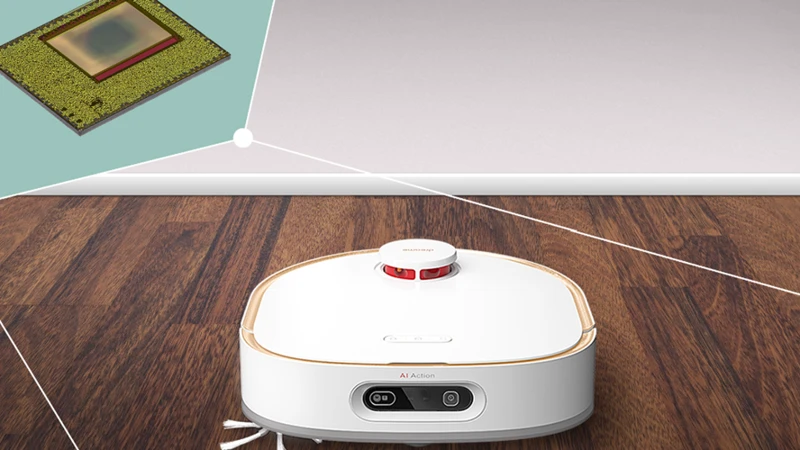
As smart vacuum cleaners become more advanced and ubiquitous, the need for efficient and smart obstacle avoidance technology has become increasingly essential. With a plethora of sensors and algorithms, these remarkable machines are evolving to map out and avoid obstacles with ease. In this section of the article, we’ll explore the different facets of this technology and how it enables smart vacuum cleaners to avoid obstructions and clean efficiently. So, grab a cup of coffee and let’s dive into the world of obstacle avoidance technology!
Mapping Technology
Mapping technology plays a crucial role in the obstacle avoidance capabilities of smart vacuum cleaners. This technology allows the device to create a map of the area it needs to clean and navigate it effectively. The map is created using a combination of sensors, cameras, and mapping algorithms.
The sensors used in mapping technology:
| Sensor | Function |
| ———– | ——————————————————- |
| Optical | Detects changes in surface height and helps maintain the distance from walls |
| Infrared | Detects objects at a distance and alerts the device to avoid collision |
| Ultrasonic | Detects the distance of objects in the vicinity of the device |
How mapping technology works:
Once the smart vacuum cleaner starts operating, it uses its sensors to create a map of the area. The mapping algorithms then analyze the data from the sensors to create a visual representation of the area. This map is then used to navigate the device through the area, avoiding obstacles and cleaning accordingly.
Motion planning algorithms:
Mapping technology is also responsible for the motion planning algorithms that the device uses for navigation. These algorithms help the device move along the most efficient path, while avoiding obstacles. This ensures that the device cleans all parts of the area effectively and efficiently, without causing any damage.
Mapping technology is a crucial component in the obstacle avoidance capabilities of smart vacuum cleaners. It allows the device to create a map of the area it needs to clean, navigate the area efficiently using motion planning algorithms, and avoid obstacles, ensuring that the device cleans effectively, without causing any damage.
Motion Planning Algorithms
Motion Planning Algorithms
Motion planning algorithms play an essential role in obstacle avoidance technology, allowing the smart vacuum cleaner to move around obstacles and successfully navigate through the environment. There are various motion planning algorithms utilized in smart vacuum cleaners, each with individual strengths and limitations.
One such algorithm is the potential field algorithm, which works by creating virtual potential fields around the obstacles in the path of the vacuum cleaner. The attractive and repulsive fields guide the robot away from and around the object, effectively avoiding it. Potential field algorithms are fast and efficient, making them ideal for real-time obstacle detection and avoidance.
Another algorithm widely used is the pathfinding algorithm, which determines the best path for the robot to follow. The algorithm takes into account the location of the obstacles and finds the optimal route that avoids colliding with them. Pathfinding algorithms are particularly useful in complex environments where there are multiple obstacles to navigate around.
Furthermore, velocity obstacle algorithm is a dynamic algorithm that predicts the future position of the robot and the obstacles surrounding it. Based on this information, the algorithm determines the limits in which the robot can move safely without colliding with any obstacles.
There are also hybrid motion planning algorithms that combine multiple algorithms. One such algorithm is the potential path planning algorithm, which uses both the pathfinding and potential field algorithms to avoid obstacles efficiently.
Combining various algorithms allows the smart vacuum cleaner to adapt to different situations, making motion planning a crucial part of the obstacle avoidance technology.
| Algorithm | Function | Strengths | Limitations |
|---|---|---|---|
| Potential Field Algorithm | Create virtual fields that guide the robot away from obstacles | Fast and efficient, suitable for real-time obstacle detection and avoidance | May not work well in complex environments with multiple obstacles |
| Pathfinding Algorithm | Determines the best path for the robot to follow | Effective in complex environments with multiple obstacles | May not work well in real-time obstacle detection and avoidance |
| Velocity Obstacle Algorithm | Predicts the future position of the robot and surrounding obstacles to determine safe limits for movement | Allows for dynamic obstacle avoidance | May require more processing power than other algorithms |
| Potential Path Planning Algorithm | Combines pathfinding and potential field algorithms for efficient obstacle avoidance | Effective in various environments and situations | May require more processing power than individual algorithms |
Obstacle Avoidance and Cleaning
When it comes to smart vacuum cleaners, obstacle avoidance is not just about preventing collisions. It’s also about ensuring efficient and thorough cleaning. Here are some ways in which obstacle avoidance and cleaning work together:
1. Multi-Directional Cleaning
Smart vacuum cleaners equipped with obstacle detection and avoidance technology can navigate around furniture and other obstructions, allowing for multi-directional cleaning. This means that the vacuum can clean in straight lines, diagonally, and even around corners. It can clean under chairs and tables without getting stuck, and it can change direction when it encounters an obstacle.
2. Targeted Cleaning
Obstacle detection sensors can also help smart vacuum cleaners target areas that need extra attention. For instance, if the robot vacuum senses a particularly dirty area, it can slow down and spend more time cleaning that spot before moving on. This is especially useful for areas with high foot traffic, like entryways and living rooms.
3. Efficient Path Planning
Smart vacuum cleaners use advanced algorithms to plan their cleaning paths. With obstacle detection and avoidance technology, these algorithms can be optimized for efficiency. The robot vacuum can determine the most efficient route to take, avoiding obstacles along the way, and covering as much ground as possible in the shortest amount of time.
4. Avoiding Damage to Property and Robot
Obstacle detection sensors also help prevent damage to the smart vacuum cleaner and the objects around it. For example, if the robot senses that it’s about to bump into a fragile item, it can slow down or stop altogether. This can prevent the item from getting knocked over or broken, and it can also prevent damage to the robot vacuum.
Obstacle avoidance and cleaning work hand in hand to ensure that smart vacuum cleaners provide effective and efficient cleaning without damaging the robot or the surrounding objects.
Benefits and Limitations
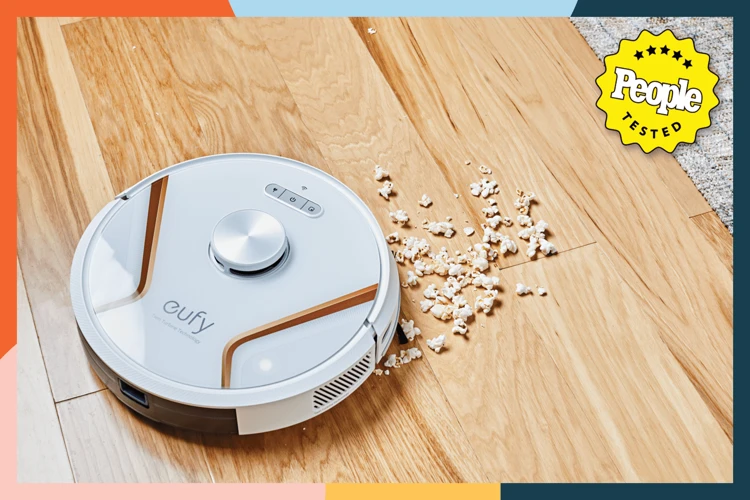
As with any technology, obstacle detection and avoidance in smart vacuum cleaners bring both benefits and limitations to the table. While these features have made vacuuming easier and more efficient than ever before, there are still certain things that they cannot do. In this section of the article, we will explore the advantages and drawbacks of obstacle detection and avoidance systems in smart vacuums.
Benefits of Obstacle Detection and Avoidance
Obstacle detection and avoidance technology has revolutionized the way smart vacuum cleaners perform their cleaning tasks. Here are some benefits of this technology that make it an indispensable feature:
- Efficient Cleaning: With obstacle detection and avoidance technology, smart vacuum cleaners can detect and navigate around obstacles, without requiring any human intervention. As a result, they can clean efficiently, cover more area in less time, and save energy.
- Increased Lifespan of Vacuum Cleaners: Since smart vacuum cleaners can detect and avoid obstacles, they are less likely to collide with objects and suffer physical damage. Consequently, the lifespan of these vacuum cleaners is increased, and their owners can save money on costly repairs.
- Improved Safety: Vacuum cleaners equipped with obstacle detection and avoidance systems can safely clean rooms without damaging furniture or other objects. This is particularly useful in households with small children or pets, where accidents are prone to occur.
- User-Friendly: With obstacle detection and avoidance technology, smart vacuum cleaners require less human intervention and can function autonomously. This makes them more user-friendly, as owners can schedule cleaning times and allow the vacuum cleaners to clean while they are away.
- Accessibility: Obstacle detection and avoidance technology make smart vacuum cleaners accessible to everyone, irrespective of age, physical ability, or mobility. Smart vacuum cleaners are particularly useful for the elderly or individuals with disabilities who may not be able to move furniture or operate traditional vacuum cleaners.
With its numerous benefits, it is no surprise that obstacle detection and avoidance technology is becoming an increasingly popular feature in smart vacuum cleaners. However, there are some limitations to this technology that are important to consider as well.
Limitations of Obstacle Detection and Avoidance
While obstacle detection and avoidance technology has revolutionized the way smart vacuum cleaners operate, it still has some limitations that need addressing. Let’s take a look at some of them in detail:
| Limitation | Description |
|---|---|
| Accuracy | The accuracy of obstacle detection technology is not 100%, and there may be instances when the vacuum cleaner fails to detect or avoid obstacles. This can result in collisions and damage to both the vacuum cleaner and the obstacle. |
| Complexity | The sensors used in obstacle detection and avoidance technology are complex and require advanced algorithms to function correctly. Any issues with the sensors or algorithms can result in the vacuum cleaner malfunctioning. |
| Cost | Smart vacuum cleaners with obstacle detection and avoidance technology are more expensive than traditional vacuum cleaners. This makes them less accessible to people who are on a tight budget. |
| Environment | Obstacle detection and avoidance technology is designed to work in specific environments, and it may not work correctly in all settings. For example, highly cluttered rooms may confuse the sensors, resulting in the vacuum cleaner malfunctioning. |
While these limitations can be frustrating for users, it’s important to keep in mind that the technology is still in its early stages and is constantly evolving. As the sensors and algorithms improve, so too will the accuracy and reliability of obstacle detection and avoidance technology. Ultimately, it’s up to individual users to determine whether the benefits of this technology outweigh the limitations.
Future of Obstacle Detection and Avoidance in Smart Vacuum Cleaners
Looking ahead, there are exciting advancements that are expected in the field of obstacle detection and avoidance in smart vacuum cleaners. One of the key areas of development is the integration of artificial intelligence (AI) and machine learning (ML) algorithms.
With AI and ML technologies, smart vacuum cleaners can learn from their environment and adapt their obstacle detection and avoidance techniques accordingly. This means that these devices can become increasingly accurate and efficient in avoiding obstacles while cleaning.
Another area of development is the use of LiDAR technology. LiDAR uses laser-based sensors to create three-dimensional maps of the cleaning area. This can enable smart vacuum cleaners to identify and avoid obstacles with greater precision and speed, resulting in even more efficient cleaning.
As smart homes and the Internet of Things (IoT) ecosystems continue to grow, it is expected that smart vacuum cleaners will become increasingly interconnected with other smart devices in the home. This could lead to even more advanced obstacle detection and avoidance techniques, as these devices can work together to create a more accurate picture of the home environment.
The future of obstacle detection and avoidance in smart vacuum cleaners is promising, and we can expect to see continued innovation in this area. As these devices become even more intelligent and efficient, they will continue to make our lives easier by taking care of one of the most tedious household chores – cleaning.
Conclusion
After going through the details of how obstacle detection and avoidance work in smart vacuum cleaners, it can be concluded that these technologies have revolutionized the cleaning industry to a great extent. With the increasing demand for time-saving and convenient cleaning solutions, smart vacuum cleaners have become a popular household gadget.
Through the use of various sensors, obstacle detection ensures that the vacuum cleaner can navigate around obstacles, prevent them from getting damaged and ensure that cleaning is carried out efficiently. On the other hand, obstacle avoidance technology takes this one step ahead and enables the vacuum cleaner to actively avoid obstacles that are in its path.
With the use of mapping technology and motion planning algorithms, the vacuum cleaner can create a virtual map of the floor space that needs to be cleaned and plan its movements accordingly. Additionally, obstacle avoidance technology ensures that the vacuum cleaner can detect and avoid obstacles such as furniture, toys, and pets.
However, like any technology, there are some limitations to obstacle detection and avoidance. Some obstacles, such as transparent objects, may not be detected accurately. Similarly, tight spaces may pose a challenge to the vacuum cleaner’s navigation ability.
Overall, the benefits of obstacle detection and avoidance technology outweigh the limitations. These technologies have simplified house-keeping by ensuring that cleaning is carried out efficiently and without any hassles. With further advancements in technology, it is expected that future versions of smart vacuum cleaners will become even more efficient and effective in cleaning various surfaces.
In conclusion, obstacle detection and avoidance have become a significant aspect of smart vacuum cleaner technology that makes cleaning more convenient and efficient. As the technology continues to evolve, we can expect to see more advanced versions of smart vacuum cleaners that might be able to save even more time and effort for homeowners.
Frequently Asked Questions
What are some common types of sensors used in smart vacuum cleaners for obstacle detection?
Common sensors used for obstacle detection in smart vacuum cleaners include infrared sensors, ultrasonic sensors, and cliff sensors.
Can smart vacuum cleaners detect and avoid low-lying obstacles like wires and cords?
Yes, most smart vacuum cleaners are equipped with sensors that detect small obstacles like wires and cords and navigate around them.
Do all smart vacuum cleaners use mapping technology for obstacle avoidance?
No, not all smart vacuum cleaners use mapping technology for obstacle avoidance. Some models use simpler motion planning algorithms to navigate around obstacles.
Can smart vacuum cleaners detect and avoid stairs?
Yes, most smart vacuum cleaners come with cliff sensors that detect stairs and prevent the device from falling off a ledge or stairs.
Is obstacle detection technology only useful for avoiding obstacles when vacuuming?
No, obstacle detection technology can also be useful for preventing collisions between the smart vacuum cleaner and furniture or other objects, protecting both the cleaner and the objects it comes into contact with.
How do smart vacuum cleaners with mapping technology create a map of the environment?
Smart vacuum cleaners with mapping technology use lasers or cameras to create a 3D map of the environment, which is then used to create a cleaning plan and navigate around obstacles.
What are some limitations of smart vacuum cleaners with obstacle detection technology?
Some limitations include difficulty navigating crowded environments or sharp corners, inability to detect clear objects like glass or plastic, and occasional errors that may cause the vacuum cleaner to collide with objects.
Can smart vacuum cleaners with obstacle detection technology be used in outdoor environments?
No, smart vacuum cleaners with obstacle detection technology are designed for indoor use only and may not be able to navigate outdoor environments effectively.
Are there any privacy concerns associated with smart vacuum cleaners with mapping technology?
Some individuals may have concerns about the privacy implications of using a smart vacuum cleaner equipped with mapping technology, as the device may be able to create a detailed map of the user’s home.
What can consumers expect from future advancements in obstacle detection and avoidance technology for smart vacuum cleaners?
Consumers can expect more advanced mapping technology, improved motion planning algorithms, and increased use of artificial intelligence and machine learning to improve the efficiency and safety of smart vacuum cleaners with obstacle detection and avoidance technology.
